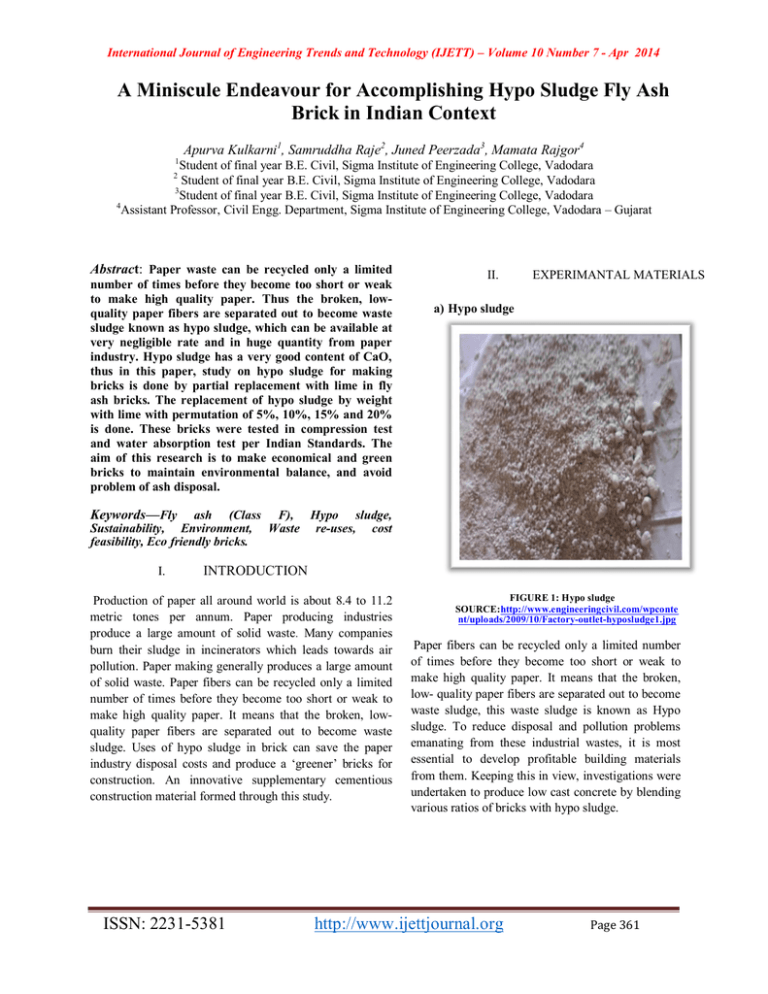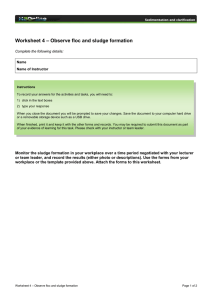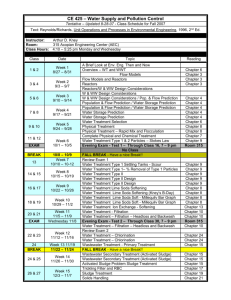A Miniscule Endeavour for Accomplishing Hypo Sludge Fly Ash Apurva Kulkarni
advertisement

International Journal of Engineering Trends and Technology (IJETT) – Volume 10 Number 7 - Apr 2014 A Miniscule Endeavour for Accomplishing Hypo Sludge Fly Ash Brick in Indian Context Apurva Kulkarni1, Samruddha Raje2, Juned Peerzada3, Mamata Rajgor4 1 Student of final year B.E. Civil, Sigma Institute of Engineering College, Vadodara Student of final year B.E. Civil, Sigma Institute of Engineering College, Vadodara 3 Student of final year B.E. Civil, Sigma Institute of Engineering College, Vadodara 4 Assistant Professor, Civil Engg. Department, Sigma Institute of Engineering College, Vadodara – Gujarat 2 Abstract: Paper waste can be recycled only a limited number of times before they become too short or weak to make high quality paper. Thus the broken, lowquality paper fibers are separated out to become waste sludge known as hypo sludge, which can be available at very negligible rate and in huge quantity from paper industry. Hypo sludge has a very good content of CaO, thus in this paper, study on hypo sludge for making bricks is done by partial replacement with lime in fly ash bricks. The replacement of hypo sludge by weight with lime with permutation of 5%, 10%, 15% and 20% is done. These bricks were tested in compression test and water absorption test per Indian Standards. The aim of this research is to make economical and green bricks to maintain environmental balance, and avoid problem of ash disposal. II. EXPERIMANTAL MATERIALS a) Hypo sludge Keywords—Fly ash (Class F), Hypo sludge, Sustainability, Environment, Waste re-uses, cost feasibility, Eco friendly bricks. I. INTRODUCTION Production of paper all around world is about 8.4 to 11.2 metric tones per annum. Paper producing industries produce a large amount of solid waste. Many companies burn their sludge in incinerators which leads towards air pollution. Paper making generally produces a large amount of solid waste. Paper fibers can be recycled only a limited number of times before they become too short or weak to make high quality paper. It means that the broken, lowquality paper fibers are separated out to become waste sludge. Uses of hypo sludge in brick can save the paper industry disposal costs and produce a ‘greener’ bricks for construction. An innovative supplementary cementious construction material formed through this study. ISSN: 2231-5381 FIGURE 1: Hypo sludge SOURCE:http://www.engineeringcivil.com/wpconte nt/uploads/2009/10/Factory-outlet-hyposludge1.jpg Paper fibers can be recycled only a limited number of times before they become too short or weak to make high quality paper. It means that the broken, low- quality paper fibers are separated out to become waste sludge, this waste sludge is known as Hypo sludge. To reduce disposal and pollution problems emanating from these industrial wastes, it is most essential to develop profitable building materials from them. Keeping this in view, investigations were undertaken to produce low cast concrete by blending various ratios of bricks with hypo sludge. http://www.ijettjournal.org Page 361 International Journal of Engineering Trends and Technology (IJETT) – Volume 10 Number 7 - Apr 2014 TABLE 1 CHEMICAL COMPOSITION OF HYPO SLUDGE Sr. No. 1 Chemical Compound Silicon Dioxide (SiO2) c) Lime Percentage 5.28% 2 Calcium Oxide (CaO) 47.84% 3 Magnesium Oxide 6.41% (MgO) 4 Sulphur Trioxide 0.19% 5 Aluminum Oxide (Al2O3) 0.09% 6 Ferric Oxide (Fe2O3) 0.73% 7 Loss on Ignition 38.26% FIGURE 3.3 Limestone quarry SOURCE: http://en.wikipedia.org/wiki/Lime_(material) SOURCE: engineeringcivil.com Pure calcium oxide is fused with coke in order to render the highest yield in the manufacture of acetylene. The quality of the resultant carbide lime is a direct result of the excellent quality raw materials. Carbide lime is finer in particle size, and physically, having a very finely divided particle size makes carbide lime better. A finer particle size means faster and more reactivity b) Flyash (Class F) d) Quarry dust FIGURE 2: Fly ash (Class F) SOURCE: “Shreeji bricks” Sarkada The burning of harder, older anthracite and bituminous coal typically produces Class F fly ash. This fly ash is pozzolanic in nature, and contains less than 20% lime (CaO). Possessing pozzolanic properties, the glassy silica and alumina of Class F fly ash requires a cementing agent, such as Portland cement, quicklime, or hydrated lime, with the presence of water in order to react and produce cementitious compounds. ISSN: 2231-5381 FIGURE 3 Quarry dust SOURCE: “Shreeji bricks” Sarkada Quarry dust is a waste product produced during the crushing process which is used to extract stone. It is rock particles. When huge rocks brake in too small parts for the construction in quarries. It is like sand but mostly grey in http://www.ijettjournal.org Page 362 International Journal of Engineering Trends and Technology (IJETT) – Volume 10 Number 7 - Apr 2014 color. It is mineral particles. The density of Quarry dust is 1650 kg/m³. e) Water Water is an important ingredient of brick as it actually used for manufacturing of brick. Since it helps to bind all the raw materials for giving proper mix. Water used for making brick should be free from impurities. III. MIX DESIGN TABLE 2 DESIGN MIX PROPORTION F.A (kg) H.S (kg) Lime (kg) Q.D (kg) 60.00 0.00 20.00 20.00 60.00 5.00 15.00 20.00 60.00 10.00 10.00 20.00 60.00 15.00 5.00 20.00 60.00 20.00 0.00 20.00 Sample STD operated in two shifts without any operation/maintenance load. The maintenance cost is so low that it can be ignored. 15 lakh bricks can be produced for each machine in its life cycle. A. Compression Test The brick specimens are immersed in water for 24 hours. The frog of the brick is filled flush with 1:3 cement mortars and the specimen are stored in damp jute bag for 24 hours and then immersed in clean water for 24 hours. The specimen is placed in compression testing machine with 6 mm plywood on top and bottom of it to get uniform load on the specimen. Then load is applied axially at a uniform rate of 14 N/mm2. The crushing load is noted. Then the crushing strength is the ratio of crushing load to the area of brick loaded. Average of five specimens is taken as the crushing strength. L1 L2 L3 L4 F.A=Fly ash, H.S = Hypo sludge, Q.D= Quarry Dust IV. EXPERIMENTAL METHODOLOGY The evaluation of Hypo sludge for use as a replacement of fly ash material begins with the brick testing. Brick contains fly ash, Lime, water, and Quarry dust. With the control brick, i.e. 5%, 10%, 15% and 20% of the lime is replaced with Hypo sludge, the data from the hypo sludge fly ash brick is compared with data from a standard fly ash brick without Hypo sludge. Five bricks samples were cast having size of 230x115x75mm.The manufacturing process of bricks broadly consists of three operations viz. mixing the ingredients, pressing the mix in the machine and curing the bricks for a stipulated period. Selection of machinery depends on the bricks mix contents. For manufacturing hypo sludge fly ash bricks, the best suited machinery is a Vibro - press machine, which is an indigenous low cost machine and can be run by ordinary semiskilled worker. Its production capacity is 1000 bricks per shift and can be ISSN: 2231-5381 SOURCE: Concrete lab “SIGMA INSTITUTE” TABLE 3 COMPRESSION STRENGTH OF BRICKS (230X115X75) AT 7, 14 AND 21 DAYS FOR HYPO SLUDGE FLY BRICKS Sample 7 DAYS 14 DAYS 21 DAYS 4.43 4.70 7.55 STD http://www.ijettjournal.org Page 363 International Journal of Engineering Trends and Technology (IJETT) – Volume 10 Number 7 - Apr 2014 L1 L2 L3 L4 5.22 6.32 7.65 4.90 6.03 7.76 3.22 4.23 6.00 1.67 2.67 3.26 10 STD 8 VII. L1 3.17 L2 2.98 L3 2.79 L4 2.61 CONCLUSION L1 6 4 L2 2 Based on limited experimental investigations concerning compressive strength of Brick, the following observations are made regarding the resistance of partially replaced hypo sludge: L3 0 7 DAYS 14 DAYS 21 DAYS STRENGTH STRENGTH STRENGTH (N/mm2) (N/mm2) (N/mm2) L4 GRAPH 1: Percentage replacement( X axis) Vs Compressive Stress VI. ECONOMIC FEASIBILITY TABLE 4 COST OF MATERIALS Material Rupees/kg 0.20 Hypo sludge 0.55 Fly ash 1.50 Lime 0.35 Quarry dust VIII. ACKNOWLEDGEMENT TABLE 5 TOTAL COST OF BRICKS OF DIFFERENT PROPORTION Samples Cost STD 3.36 ISSN: 2231-5381 a) Compressive strength increases on increase in percentage of Hypo sludge as compare to lime. (b) Use of Hypo sludge in brick can solve the disposal problem; reduce cost and produce a ‘greener’ Ecofriendly bricks for construction. (c) Environmental effects of wastes and disposal problems of waste can be reduced through this research. (d)A better measure by an innovative Construction Material is formed through this research. (e) This study helps in converting the nonvaluable Hypo sludge into bricks and makes it valuable. (f) Hypo sludge bricks reduce the seismic weight of building. (g) It reduces the density of brick masonry from 20 (clay bricks) to 12(Hypo sludge bricks) (h) It reduces the cost of material per unit The author thankfully acknowledge to Dr. F.S. Umrigar, Principal, Prof. Jayeshkumar Pitroda, Prof.J.J.Bhavsar, Associate Professor and PG (Construction Engineering and Management) Coordinator, B.V.M. Engineering College, Mr. Sailesh Shah Chairman of Sigma Institute of Engg. Asst. Professor Patel Ankit, Asst. Professor Rajgor Mamta, Lab Asst. Dinubhai . G. Desai, Sigma Institute of Engineering,Vadodara, Gujarat. http://www.ijettjournal.org Page 364 International Journal of Engineering Trends and Technology (IJETT) – Volume 10 Number 7 - Apr 2014 IX. [15] REFERENCES [1] Durability of concrete with Partial Replacement of Cement by Paper Industry Waste (Hypo Sludge). [2] Durability of concrete with Partial Replacement of Cement by Paper Industry Waste (Hypo Sludge) [11] V. S. Aigbodion*, S. B. Hassan, T. Ause and G.B. Nyior V Karthikeyan and M Ponni (2006), “An Experimental Study of Utilization of Fly Ash for Manufacturing of Bricks”, 22nd National Conference of Architectural Engineers Trichur. “Potential Utilization of Solid Waste (Bagasse Ash) “Journal of Minerals & Materials Characterization & Engineering, Vol. 9, No.1, pp.67-77, 2010 [3] Environmental Construction and Valuation [Research -Paper]. [4] “Engineering Materials” by R. K. Rajput, S. Chand & Company Ltd. [5] Gujarat Narmada Fly ash Company Limited, 901, A- Wing, Alkapuri Arcade, R. C. Dutt Road, Vadodara -390 005 [6] Innovative Use of Paper Industry Waste (Hypo Sludge) In Design Mix Concrete [7] IS: 3495 (Part 1 and 2)-1992, Methods of tests of Burnt Clay Building Bricks—Specification, Bureau of Indian Standards, New Delhi. [8] Mamta B. Rajgor, Prof. JayeshkumarPitroda “A study of utilization aspect of stone waste in Indian context.” [9] Om Prakash (1990), “Utilization of Pulverized (Fertilizer Plant) Fly Ash as Low-Cost Bricks and Construction Material” M. Tech. Thesis Submitted to MNREC, Allahabad [10] Riddhish shah, JayeshPitroda “Recycling of Construction Material for Sustainability” published in National Conference on Recent Trends in Engineering & Technology, (NCRTET-2011) B.V.M. Engg. College, V.V.Nagar, Gujarat 13th -14th May 2011. [11] Rajiv Sinha, “Extract from paper 'Technology: Fly ash Disposal and Utilization: The Indian Scenario”, Department of Civil Engineering, IIT Kanpur [12] Study of Modulus of Elasticity of Concrete with Partial Replacement of Cement by Hypo Sludge Waste from Paper Industry. [13] Utilization of Hypo Sludge by Eco-Efficient Development of Rigid Pavement in Rural Roads. [14] V. S. Aigbodion*, S. B. Hassan, T. Ause and G.B. Nyior “Potential Utilization of Solid Waste (Bagasse Ash) “Journal of Minerals & Materials Characterization & Engineering, Vol. 9, No.1, pp.67-77, 2010 ISSN: 2231-5381 http://www.ijettjournal.org Page 365





